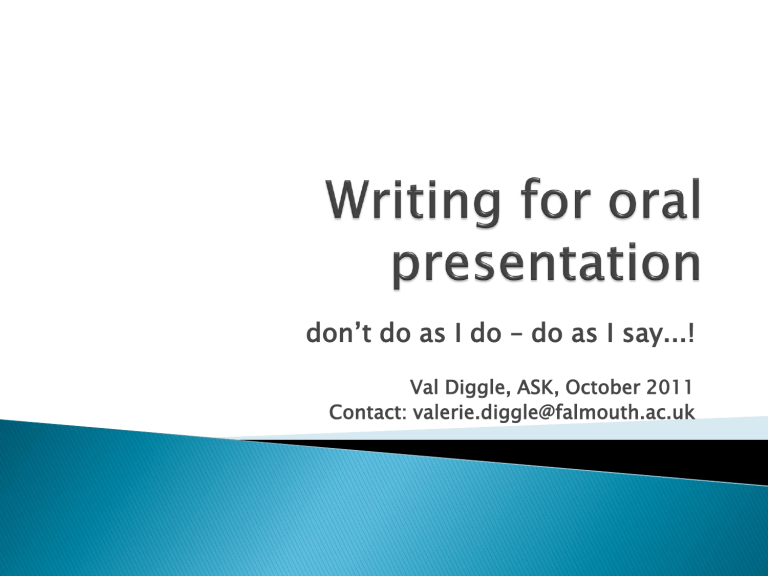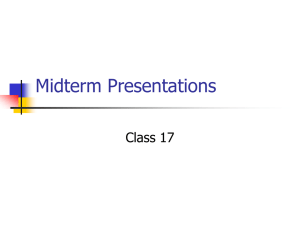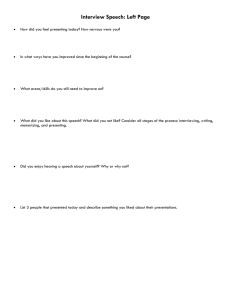Writing for oral presentation

don’t do as I do – do as I say...!
Val Diggle, ASK, October 2011
Contact: valerie.diggle@falmouth.ac.uk
Who are they and what are they expecting?
Why is it important to present the information orally?
What is the key focus of your presentation?
Are they more or less knowledgeable about your topic than you?
In a talk there is usually only one chance for the audience to understand what you are saying
but you can…
Use your voice, eye contact, body language to compensate
Make your presentation inter-active
Vary the pace
Inject some humour without sacrificing academic credibility
In an oral presentation it is perfectly OK to
Use the first person
Keep ideas simple
Use contractions (I’ll , doesn’t..)
Keep speech natural by avoiding conjunctions like “additionally” and “however” –
Use phrases like “the next point to focus on” instead
Because there is no written text to refer to
Foreshadow or guide the listener
Use phrases like
“I’d like to move on to…”
“The focus of this presentation will be..”
Unpack your language
Don’t make it too academically dense
Avoid acronyms and subject specific jargon
The audience cannot refer back to what you said previously in order to keep up
Your talk will need a structure
This could be historical/chronological or procedural – step-by-step
Or group similar ideas together thematically
Briefly introduce your topic
Summarise what you have covered – don’t just stop
Timing is crucial
If you go over time when presenting at a conference it will irritate everybody
It will rob the next presenter of some of their
(brief) chance to shine
You need to allow time for questions at the end
Only write what you can actually say in the allocated time slot
Typically this is only 15-20 minutes with 10 minutes for questions
One typed A4 page – 12pt font – 2cm margins - 1.5 line spacing - takes approx
5minutes to read aloud at a conversational pace
Be prepared for the technology to fail
Have full notes and OHPs as back up
Use large enough, easy to read font
Only use relevant visual imagery
Clip art
Sound effects
Slide transitions/fancy animations – all the bells and whistles in PowerPoint were designed for
selling
not
educating
non-standard fonts
Slabs of text
Don’t be tempted just to read it aloud – this will
Make you lose eye-contact
Risk using a boring monotone
Encourage poor posture
Practice filling in the gaps between points
Use points that are additional to the ones on the slides
The presentation should give people the gist of your contribution
It should make them want to read it, to find out more later
You can refer to information that it is not possible to include adequately in your talk
Your audience will probably be suffering from information fatigue before you open your mouth
Try to keep a roving eye contact with them
Stand up straight and use appropriate gestures
Check that you can be heard – vary the pace of the delivery – use silences and pauses and interesting intonation patterns
You probably won’t
Some degree of nervousness is useful
Everybody feels nervous - some people are better at disguising it try to act not nervous
Take deep breaths, remind yourself to slow down – not gabble
Focus on your message – what you are there for
Many people in your audience will also be presenting and so sympathetic to your ordeal
Your worst crime will be to go over-time as this will subvert their expectations and make them bored, impatient and confused
Timing is an easy one to get right if you practice
Use about one slide every 2 mins – about a dozen slides for a 20 min presentation
Most of us use way more than that !
Slide 1 – title/author/affiliation
Slide 2 – Forecast
This is the gist – the “abstract” of an oral presentation – what is the problem/your insight about..?
Slide 3 – Outline
How will the talk be structured ? Audiences like predictability…
Slides 4-5 your motivation and problem statement
Why should anyone actually care ? Don’t assume that your audience will feel the same about your research as you
Involve the group at this point to try to get some interaction, if appropriate
Slide 6 methods – in brief, refer to paper
Slides 7- 11
Main points – the results and insights should be covered well.
Avoid dishing out numbers or presenting tables and numerical charts without interpretation
Slide 12 – the summary

